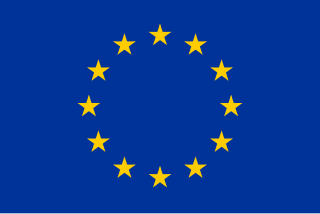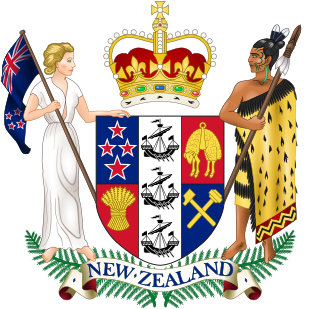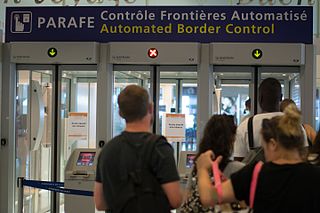 W
WU.S. citizens and permanent residents entering Canada by land are required to possess the requisite documentation, and to meet other criteria before they are allowed entry into Canada. Consequently, travelers must also meet the requirements for re-entering the U.S. at the end of their visit.
 W
WThe APEC Business Travel Card (ABTC) is a travel document issued to business travellers who are citizens of APEC participating economies. Valid for five years, the card eliminates the need for its holder to possess a visa when visiting other APEC participating economies as long as pre-clearance has been obtained during the application process.
 W
WAutomated border control systems (ABC) or eGates are automated self-service barriers which use data stored in a chip in biometric passports along with a photo or fingerprint taken at the time of entering the eGates to verify the passport holder's identity. Travellers undergo biometric verification using facial or iris recognition, fingerprints, or a combination of modalities. After the identification process is complete and the passport holder's identity is verified, a physical barrier such as a gate or turnstile opens to permit passage. If the passport holder's identification is not verified or if the system malfunctions, then the gate or turnstile does not open and an immigration officer will meet the person. E-gates came about in the mid-2000s as an automated method of reading the then-newly ICAO mandated e-passports.
 W
WThe Common Travel Area is an open borders area comprising the United Kingdom, the Republic of Ireland, the Isle of Man, and the Channel Islands. The British Overseas Territories are not included. Based on agreements that are not legally binding, the internal borders of the CTA are subject to minimal controls, if any, and can normally be crossed by British and Irish citizens with minimal identity documents with certain exceptions. The maintenance of the CTA involves co-operation on immigration matters between the British and Irish authorities.
 W
We-Channel, also known as The Automated Passenger Clearance System, is an expedited border control system introduced by the Hong Kong Immigration Department in 2004, designed to speed up border immigration processes for residents of Hong Kong, Macau and frequent visitors to Hong Kong entering and exiting the territory whether it be by land, air or sea via the use of self-service kiosks employed at various border control points.
 W
WePassport gates are automated self-service barriers operated by the Polizia di Frontiera and located at selected immigration checkpoints in non-Schengen arrival and departure halls in some airports across Italy, offering an alternative to using desks staffed by immigration officers. The gates use facial recognition technology to verify the user's identity against the data stored in the chip in their biometric passport. As of 18 August 2020, due to the Italian Government COVID-19 restrictions, the eGates cannot be used on arrival and all incoming travelers are processed manually.
 W
WBorder control is the measures taken by a state or a bloc of states to monitor its borders and regulate the movement of people, animals, and goods across the border.
 W
WThe visa policy of Australia deals with the requirements that a foreign national wishing to enter Australia must meet to obtain a visa, which is a permit to travel, to enter and remain in the country. A visa may also entitle the visa holder to other privileges, such as a right to work, study, etc. and may be subject to conditions.
 W
WThe visa policy of Canada requires that any foreign national wishing to enter Canada must obtain a temporary resident visa from one of the Canadian diplomatic missions unless they hold a passport issued by one of the 54 eligible visa exempt countries and territories or proof of permanent residence in the United States.
 W
WVisitors to India must obtain a visa from an Indian diplomatic mission unless they come from one of the visa-exempt countries or a country whose citizens may obtain a visa on arrival, or an e-Visa online.
 W
WePassport gates are automated self-service barriers operated by the UK Border Force and located at immigration checkpoints in arrival halls in some airports across the UK and at the juxtaposed controls in international railway terminals abroad, offering an alternative to using desks staffed by immigration officers. The gates use facial recognition technology to verify the traveller's identity against the data stored in the chip in their biometric passport, as well as run the data against numerous databases to determine if the traveller is a security risk.
 W
WThe visa policy of the Schengen Area is set by the European Union and applies to the Schengen Area and to other EU member states except Ireland. The visa policy allows nationals of certain countries to enter the Schengen Area via air, land or sea without a visa for stays of up to 90 days within a 180-day period. Nationals of certain other countries are required to have a visa either upon arrival or in transit.
 W
WGlobal Entry is a program of the U.S. Customs and Border Protection service that allows pre-approved, low-risk travelers to receive expedited clearance upon arrival into the United States via the SENTRI and NEXUS lanes and through automatic kiosks at select airports. As of May 4, 2018, Global Entry was available at 53 US airports and 15 preclearance locations. By April 2018 more than 5 million people were enrolled in Global Entry and approximately 50,000 new applications for the program were being filed monthly.
 W
WINSPASS, or INS Passenger Accelerated Service System, was a program of the United States Immigration and Naturalization Service (INS) during the 1990s and early 2000s the purpose of which was to facilitate the entry of pre-screened low-risk travellers through immigration and customs at certain airports.
 W
WThe Mini-Schengen Area is a planned economic zone between Albania, Kosovo, North Macedonia and Serbia that was first announced in 2019. The nickname refers to the Schengen Area, a common travel area that includes 26 European countries but not the aforementioned Balkan countries. The idea of the area was brought by Edi Rama in Berlin when he discussed it with the interested nations. Rama took the idea of the former Prime Minister of Albania Fatos Nano, but the idea at that time was impossible to do when Nano was Prime Minister.
 W
WNon–New Zealand citizens wishing to enter the Realm of New Zealand must obtain a visa unless they area citizen or permanent resident of Australia or a citizen of one of the 60 visa waiver eligible countries and territories a holder of the United Nations laissez-passer or eligible for visa-free travel under other specific provisions.
 W
WNEXUS is a joint Canada Border Services Agency and U.S. Customs and Border Protection-operated Trusted Traveler and expedited border control program designed for pre-approved, low-risk travelers. Members of the program can avoid waits at border entry points by using reserved lanes at land crossings into Canada and the United States, by using self-serve kiosks at airports in Canada, the US and some international locations, or by phoning border officials for a marine entry. A NEXUS membership card is a valid document under the Western Hemisphere Travel Initiative (WHTI), so it can be used in place of a passport, including by air if flying between the US and Canada.
 W
WThe Nordic Passport Union allows citizens of the Nordic countries – Iceland, Denmark, Norway, Sweden, and Finland – to travel and reside in another Nordic country without any travel documentation or a residence permit. Since 25 March 2001, all five states have also been within the Schengen Area. The Faroe Islands are part of the Nordic Passport Union but not the Schengen Area, while Greenland and Svalbard are outside both. However, Greenland has an open border with all Nordic countries, and allows Nordic citizens to enter, settle and work without requiring a passport or permits. Svalbard allows Nordic citizens to settle and work without permits, as a result of the Svalbard Treaty, however valid travel documentation is required to enter Svalbard. Norwegian citizens may use other documents such as a Norwegian driving licence until 31 December 2021. Furthermore, as citizens of a Nordic country, those from Svalbard and Greenland are permitted to reside in any other Nordic country.
 W
WAn open border is a border that enables free movement of people between jurisdictions with few or no restrictions on movement, that is lacking substantive border control. A border may be an open border due to intentional legislation allowing free movement of people across the border, or a border may be an open border due to a lack of legal controls, a lack of adequate enforcement or adequate supervision of the border. An example of the former is the Schengen Agreement between most members of the European Economic Area. An example of the latter has been the border between Bangladesh and India, which is becoming controlled. The term "open borders" applies only to the flow of people, not the flow of goods and services, and only to borders between political jurisdictions, not to mere boundaries of privately owned property.
 W
WPARAFE is a passport verification program operated by France's Direction centrale de la police aux frontières. PARAFE, incorporating automated self-service barriers operated by DCPAF, is located at immigration checkpoints in the arrival and departure halls at the Paris, Marseille, Nice and Lyon airports and at London St. Pancras train station, offering an alternative to using desks staffed by immigration officers. The gates use facial recognition technology to verify the user's identity against the data stored in the chip in their biometric passport.
 W
WThe Registered Traveler Pilot Program was an airline passenger security assessment system tested in the United States air travel industry in 2005. It was used in several U.S. airports in a voluntary pilot phase and continues in operation in several airports around the country. It is administered by TTAC, the Transportation Security Administration (TSA) office responsible for Secure Flight, the replacement for the Computer Assisted Passenger Prescreening System (CAPPS) and the canceled CAPPS II counter-terrorism system. Registered Traveler is a public and private partnership between the TSA and the Registered Traveler Interoperability Consortium (RTIC) providing rules and standards for private Enrollment Providers that sign up participants. At 11:00 p.m. PST on June 22, 2009, Clear ceased operations because Clear and its parent company, Verified Identity Pass, Inc., filed for bankruptcy. The company was then acquired by Alclear LLC and "Clear lanes" were opened at Denver International Airport, Orlando International Airport, Dallas/Fort Worth International Airport, and San Francisco International Airport. Clear is currently operating at 60 airports, airports, stadiums, and other venues nationwide as of January 2020.
 W
WThe Schengen Area is an area comprising 26 European countries that have officially abolished all passport and all other types of border control at their mutual borders. The area mostly functions as a single jurisdiction for international travel purposes, with a common visa policy. The area is named after the 1985 Schengen Agreement signed in Schengen, Luxembourg.
 W
WThe Secure Electronic Network for Travelers Rapid Inspection (SENTRI) provides expedited U.S. Customs and Border Protection (CBP) processing, at the U.S.-Mexico border, of pre-approved travelers considered low-risk. Voluntarily applicants must undergo a thorough background check against criminal, customs, immigration, law enforcement, and terrorist databases; a 10-fingerprint law enforcement check; and a personal interview with a CBP Officer. The total enrollment fee is $122.50, and SENTRI status is valid for 5 years.
 W
WSmartGate is an automated self-service border control system operated by the Australian Border Force and New Zealand Customs Service and located at immigration checkpoints in departure and arrival halls in ten Australian international airports, and 4 New Zealand international airports. SmartGates allow Australian ePassport holders and ePassport holders of a number of other countries to clear immigration controls more rapidly, and to enhance travel security by performing passport control checks electronically. SmartGate uses facial recognition technology to verify the traveller's identity against the data stored in the chip in their biometric passport, as well as checking against immigration databases. To use the SmartGate system, the traveller must have a biometric passport from Australia, New Zealand or certain other countries. The ePassport gate scanner reads all the information contained in the chip inside the passport and runs the data against numerous databases to determine if the traveller is a security risk, while a camera takes a picture of the traveller and an officer at a control station behind the gates checks that the image captured by the camera matches the one on the passport. Once the data verification and facial recognition process is complete, doors will automatically either open, signifying that the traveller is permitted to enter and/or exit the country, or remain closed and a stop icon illuminate, demonstrating that the traveller has failed the security checks and will personally meet with immigration officials.
 W
WThe Trans-Tasman Travel Arrangement (TTTA) is an arrangement between Australia and New Zealand which allows for the free movement of citizens of one of these countries to the other. The arrangement came into effect in 1973, and allows citizens of each country to reside and work in the other country, with some restrictions. Other details of the arrangement have varied over time. From 1 July 1981, all people entering Australia have been required to carry a passport. Since 1 September 1994 Australia has had a universal visa requirement, and to specifically cater for the continued free movement of New Zealanders to Australia the Special Category Visa was introduced for New Zealanders.
 W
WThe United States passport card is a limited travel document issued by the United States federal government in the size of a credit card. Like a U.S. passport book, the passport card is only issued to U.S. nationals exclusively by the U.S. Department of State, compliant to the standards for identity documents set by the REAL ID Act, and can be used as proof of U.S. citizenship and identity. The passport card allows its holders to travel by domestic air flights within the United States, and to travel by land and sea within North America. However, the passport card cannot be used for international air travel.
 W
WUtopia for Realists: The Case for a Universal Basic Income, Open Borders, and a 15-hour Workweek is a book by Dutch popular historian Rutger Bregman. It was originally written as articles in Dutch for a virtual journal, De Correspondent, and was since compiled and published, and translated into several languages. It offers a critical proposal that it claims is a practical approach to reconstructing modern society to promote a more productive and equitable life based on three core ideas:a universal and unconditional basic income paid to everybody a short working week of fifteen hours open borders worldwide with the free movement of citizens between all states